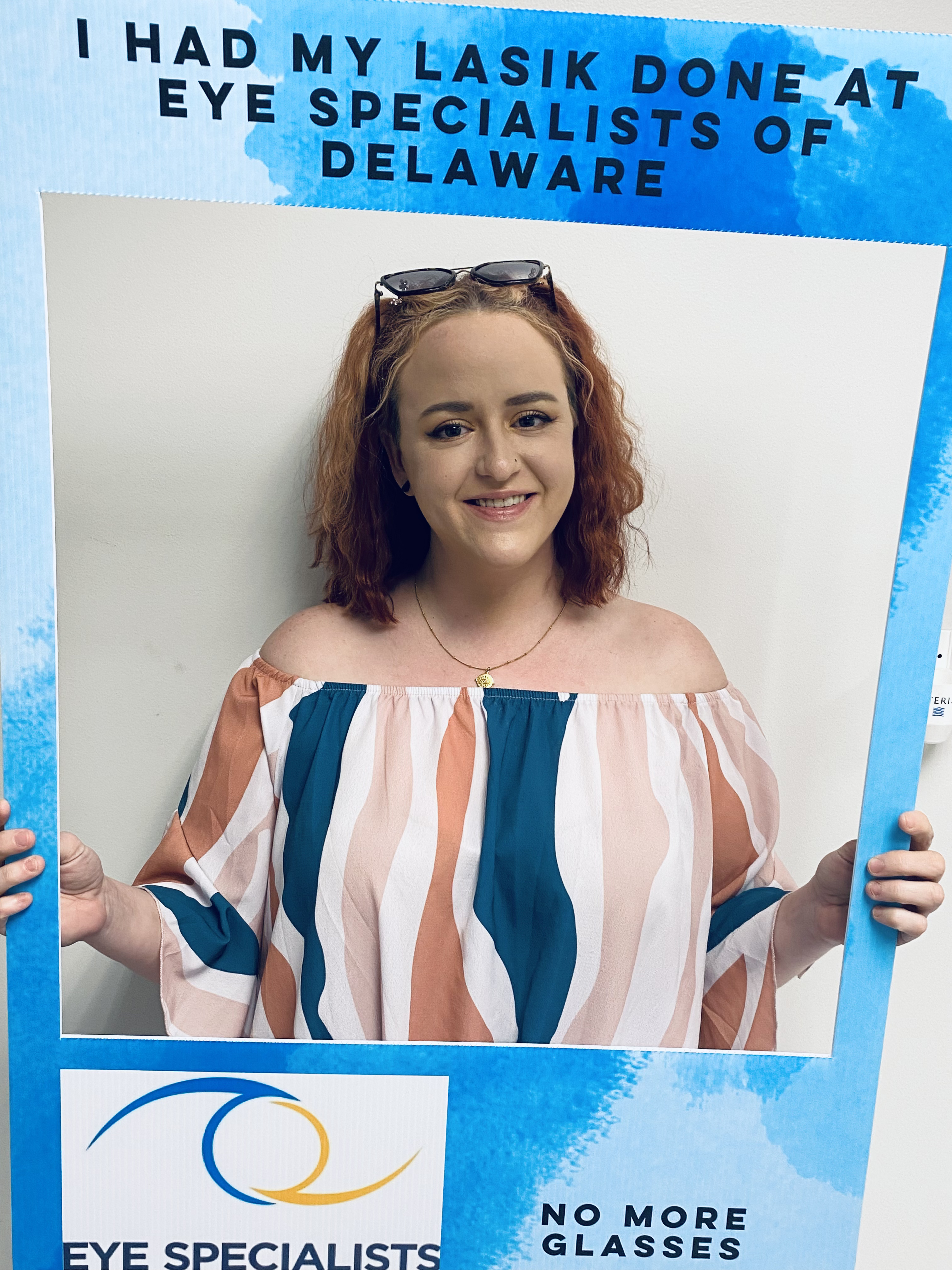LASIK OVERVIEW
Are you tired of wearing glasses all the time or wrestling with contacts daily? How would you like to wake up and be able to see you alarm clock clearly?
Most people have probably heard about LASIK, the refractive eye procedure that can help treat nearsightedness, farsightedness and astigmatism. It has become a popular procedure for more people to get the eyesight they have always wanted without the need for glasses or contacts.
WHAT IS LASIK?
LASIK stands for Laser-Assisted in Situ Keratomileusis and is the most frequently performed laser vision correction procedure. The surgery is quick and painless and designed to change the shape of the cornea so when light enters the eye it is projected onto the retina properly for excellent vision. The surgeon lifts a thin flap of tissue on the outer surface of the cornea, then the cool beam of the excimer laser is used to reshape the underlying cornea. The flap is then replaced and bonds without the need for stitches.
WHO’S A TYPICAL CANDIDATE?
UNDERSTANDING LASIK SURGERY
CUSTOM LASIK
Personalized to the unique characteristics of each eye to produce sharper, clearer, more accurate vision, particularly for patients with more severe vision problems. Improved night vision and reduced glare have also been reported with custom LASIK.
If you’re like most of our patients, you’ll be amazed at the sharpness and clarity of your vision, and enjoy more freedom from glasses and contact lenses. Your own results will depend on the level of your original vision problem and the overall health of your eyes.
Upon completion of your exam and verification of your candidacy, your surgeon will then discuss the refractive procedure that is best for you.
If you are looking to improve your vision and if you want to find out if you are an ideal candidate, schedule a free consultation today.
CONTOURA CUSTOM TREATMENT
The eye surgeons at Eye Specialists of Delaware are very excited to announce the arrival of the most advanced laser platform currently available in the United States: Contoura™ Vision Topography-Guided Laser Vision Correction. Contoura™ Vision is a step into the future of refractive surgery, offering a way to improve the quality of vision so significantly that many patients can see more clearly without corrective eyewear than they ever did with it.
Quite simply, our ophthalmologists believe that there is no other LASIK technology currently available that compares with Contoura™ Vision when it comes to accuracy and precision. This diagnostic technology can meticulously identify and record irregularities in the cornea’s curvature as well as its optics. During LASIK, this information is combined with the patient’s corrective eyewear prescription to dramatically improve vision for those suffering from nearsightedness (myopia) and astigmatism. While standard LASIK surgery has been helping individuals enhance correct visual refractive errors for many years, Contoura™ Vision takes the treatment a step further by offering even greater degrees of enhanced vision quality. Potential benefits of this technique can also include a reduced “glare” at night, improved crispness and quality of vision. Our LASIK Coordinator will be happy to meet with you for an initial consultation and eye evaluation to determine whether this treatment is ideal for your needs.
The entire team at Eye Specialists of Delaware is excited to bring Topography-Guided Laser Vision Correction to our patients in Delaware. Please contact us today with any questions you may have, or to schedule a consultation.
Are You a Candidate for Topography-guided LASIK?
Your candidacy for Contoura® Vision depends on a thorough consultation by an experienced LASIK surgeon to determine if the procedure is a good fit for you.
Topography-Guided LASIK is also especially helpful to patients with a variety of vision problems such as myopia (nearsightedness), irregular corneas and/or astigmatism. By utilizing personalized diagnostic technology to identify and record imperfections in the curvature and optics of the cornea, then combining those measurements with the eyeglass prescription to give the eyes a better focusing surface, Contoura® Vision helps patients who might otherwise not be candidates for LASIK.
During your initial LASIK and eye consultation, the Eye Specialists of Delaware doctor will talk with you about your candidacy and determine if Topography-Guided Laser Vision Correction is right for your needs.
How Does Topography-guided LASIK Work?
The Contoura® Vision laser treatment smoothes out any surface irregularities on your cornea, significantly improving the quality of vision for patients after the procedure. The advanced laser technology takes several topographical images of your eye and analyzes the 22,000 unique elevation points on the cornea in order to recommend a custom treatment.
Topography-guided LASIK Results
Most Contoura® Vision patients reported improved vision equal to or better than glasses in clinical studies. The procedure enhanced not only how much patients saw, but also reduced the severity of common visual complaints like light sensitivity, difficulty driving at night and glare.
In clinical trials, 92% of patients that had the Contoura® Vision treatment reported seeing 20/20 or better, 12 months after their procedure. Some patients even reported better than 20/20 vision. A published study established that nearly 65% of eyes treated with Contoura® Vision experienced 20/16 vision or better, while 34.4% could see 20/15 or better.

"Contoura LASIK is nothing short of life changing. The ability to “get up and go” in the mornings without having to worry if I remembered my clear lenses and suns on top of my coffee is amazing! The procedure is very quick, completely painless, and the surgical team is phenomenal at addressing all of your questions and concerns. The visual quality after surgery is far superior to any pair of glasses I’ve ever owned."
-- Carrie Gambrill


HOW WAVEFRONT WORKS
Light can be thought as traveling in a series of flat sheets, known as wavefront. To clarify the confusion about light traveling as waves instead of rays, waves are just perpendicular to light rays. These light waves are wrinkled or distorted as they pass through imperfections in the eye. These errors can be displayed on a color map of the wavefront image, which is the tool that is used to diagnose, and then determine corrections for the aberrations in the eye.
There are several ways of analyzing the optical system of the eye using wavefront technology. The most common, the Hartmann-Shack wavefront sensing method, deals with light waves as they exit the eye. In this system, the surgeon or other professional shines a small, low intensity laser into the eye, and the patient focuses on the light. As that light scatters off the retina (the rear most portion of the eye) it passes through the lens, the rear portion of the cornea (the crystalline front part of the eye) and the front part of the cornea. Thus, the emerging waves of light are distorted by the impactions in the total visual system of the eye. After leaving the eye, the light passes through an array of many small lenses in the sensing device (called aberrometer), and is focused into spots, which are recorded by a special camera. The deviation of the spots from their location provides information on wavefront error.
WAVEFRONT-GUIDED TREATMENT
The goal of wavefront-guided laser treatment is to make corrections in the surface of the cornea that compensate for errors in the total visual system. In this way a wavefront treatment is customized to the characteristics of each eye and intended to minimize higher-order aberrations so that the greatest quality of vision can be achieved.
SCHEDULE YOUR CONSULTATION TODAY
If you would like to learn more about what the Eye Specialists of Delaware has to offer and why our physicians
rank among the best LASIK surgeons in Delaware, we invite you to schedule a consultation today!
